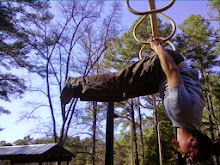Kick Your Shoes Off, Free your Feet, tell your nervous system you care
"There's been a LOT of work in the past 4-5 years about new research in foot ware and care. Guess what? feet work. All by themselves.
Guess what else? shoes stop feet from working. That's a pretty global condemnation but it's true: with a handful of exceptions, modern shoes are based on 200 year old technology (the lasts of shoe design), and for the most part are way way way too restrictive to let our feet do their thing.
It's not just four inch heels or wing tips that are the problem: it's also flip flops and horror of horrors those gorgeous high tech trainers with designs to "correct" supination or too much pronation or heel strike or whatever. And just when you realize that that's as bad as putting the foot into a cast, we find that flip flops and Birkenstocks sandles are equally horrific for other reasons: toes have to claw onto the sandle to keep them on. Despite claims that such "foot muscle work" is good for you, it really isn't. The body doesn't keep our feet in flexion (toes curled) with every step we take when we walk barefoot. Why? Our feet are one of the most jointed parts of our body (after the skull and the hands) and yet daily, what do we do? Lace up shoes to restrict those bones from doing what they were designed to do to support us: MOVE.THere's a fantastic piece in the New York Magazine from earlier this year that describes most of the latest research and why shoes suck. Recommended reading.

Lots of joints in the foot, huh?
One benefit of freeing the feet this article doesn't touch on is the relation of squished feet to the nervous system. We don't talk about the nervous system much, it's just sorta there, right? But here's the thing: the nervous system, as described by Eric Cobb, is hard wired to check only very few things. One of these, demonstrated in the startle reflex, is not fight or flight, but the very binary Threat or No Threat. "We're geared to optimize for survival, not performance," according to Cobb. Most of the nerves in our bodies designed to detect how we're moving in space are at the joints. Guess what happens in terms of that Threat/No Threat thing if our joints are squished and so not sending happy "we're free and moving" signals back to the rest of the system? Is that going to be interpretted as a Threat or a No Threat?
As Cobb demonstrates in his seminars, because we're totally connected systems, optimized for survival, if we get a message somewhere in our body that says there's a signal interruption, other parts of the body respond - and they respond immediately. In one demo, Cobb did a muscle test on a barefooted athlete to check for hamstring (back of the leg) strength. Rock solid. He then simply grabbed the athlete's foot, holding it snugly as in a laced shoe, and did the muscle test again. It was like those leg muscles got unplugged. Why?
This shut down response is part of the signaling process that says if there's something wrong somewhere, we your nervous system, don't want you exerting effort that could put you at further risk. Attend!
So above and beyond all the amazing stories about how shoes are bad for us biomechanically - because they get in the way of our own vastly superior biomechanics - they're also bad for us neurologically. Squished or non-mobile joints tell our body there's a problem. Every step we take with these immobilized joints sends that message "there's a problem; there's a problem: threat threat threat."
As most of us have experienced, if we don't attend to the quiet signals, our body has a way of sending messages out to get attention. And not necessarily at the site of the problem. Restricted feet lead to knee issues, or a hip issue or back issue, or shoulder ache or a jaw pain or maybe a wrist pain, to name a few hot spots."
This post was taken from 'IamgeekFit' blogger. It struck some cords with me as to what I've been trying to tell folks for a while now. Here's another example--for ladies who wear pointy toed, high heels, what is the first thing you do when you take your shoes off? Take a deep breath right? That's because the feet have been CONFINED.
You go geek fit dude...
.jpg)




